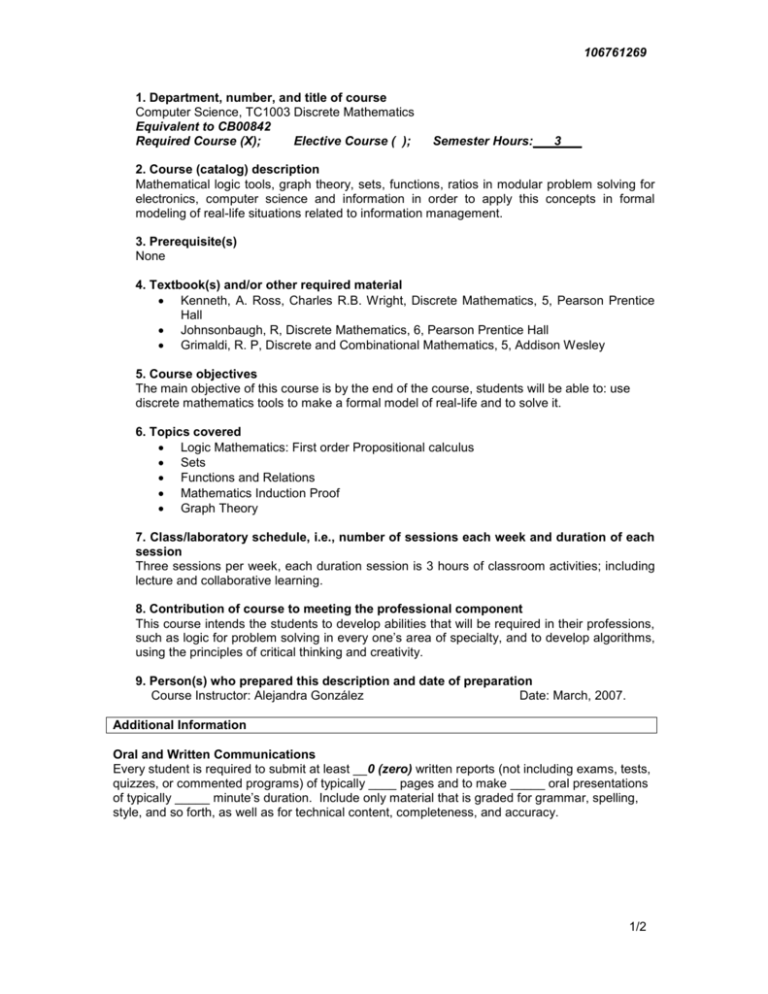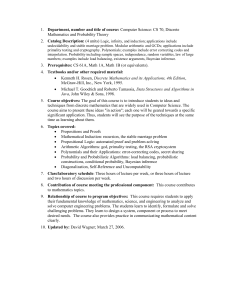
106761269
1. Department, number, and title of course
Computer Science, TC1003 Discrete Mathematics
Equivalent to CB00842
Required Course (X);
Elective Course ( );
Semester Hours:___3___
2. Course (catalog) description
Mathematical logic tools, graph theory, sets, functions, ratios in modular problem solving for
electronics, computer science and information in order to apply this concepts in formal
modeling of real-life situations related to information management.
3. Prerequisite(s)
None
4. Textbook(s) and/or other required material
Kenneth, A. Ross, Charles R.B. Wright, Discrete Mathematics, 5, Pearson Prentice
Hall
Johnsonbaugh, R, Discrete Mathematics, 6, Pearson Prentice Hall
Grimaldi, R. P, Discrete and Combinational Mathematics, 5, Addison Wesley
5. Course objectives
The main objective of this course is by the end of the course, students will be able to: use
discrete mathematics tools to make a formal model of real-life and to solve it.
6. Topics covered
Logic Mathematics: First order Propositional calculus
Sets
Functions and Relations
Mathematics Induction Proof
Graph Theory
7. Class/laboratory schedule, i.e., number of sessions each week and duration of each
session
Three sessions per week, each duration session is 3 hours of classroom activities; including
lecture and collaborative learning.
8. Contribution of course to meeting the professional component
This course intends the students to develop abilities that will be required in their professions,
such as logic for problem solving in every one’s area of specialty, and to develop algorithms,
using the principles of critical thinking and creativity.
9. Person(s) who prepared this description and date of preparation
Course Instructor: Alejandra González
Date: March, 2007.
Additional Information
Oral and Written Communications
Every student is required to submit at least __0 (zero) written reports (not including exams, tests,
quizzes, or commented programs) of typically ____ pages and to make _____ oral presentations
of typically _____ minute’s duration. Include only material that is graded for grammar, spelling,
style, and so forth, as well as for technical content, completeness, and accuracy.
1/2
106761269
Theoretical Content
Logic Mathematics: First order Propositional calculus
Sets
Mathematics Induction Proof
Functions and Relations
Graph Theory
13 hours
5 hours
6 hours
10 hours
6 hours
Collaborative Skills
The students work in teams of two members during the development of a two projects, a develop
of a two different programs about the some different numerical methods. Example: Matrices,
vectors and other about interpolation.
Indicate if the course has a significative design content
This course has a significative design content because there are in-class activities where
students must collaborate to find the solutions of some problems. Students develop two group
projects where all of the members in each group have to collaborate to be successful in the
course.
List examples of evidences such as homework sets, projects, cases, studies and exams
developed by students (collect and keep low, medium and high performances please).
Homework sets (solving problems and discuss possible solutions)
Classroom practice (exercise and practice about some topics)
Quiz (about readings and about the answers of several questions)
Exams (3 partial exams and 1 final exam)
Indicate the course distribution in terms of: lecture, laboratory, recitation and other.
The course distribution is: 80% lecture and 20% recitation.
Estimate Curriculum Category Content (Semester hours)
Area
Algorithms
Software Design
Core
2
Advanced
Area
Data Structures
Programming
Languages
Core
1
Advanced
Computer
Architecture
Laboratory projects (specify number of weeks on each)
None
Social and Ethical Issues
None
Problem Analysis
None
Solution Design
None
2/2










